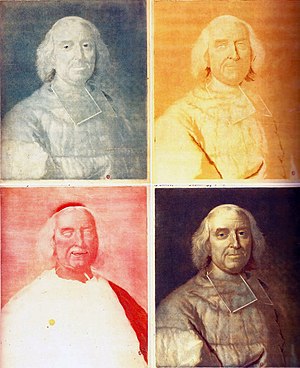Jakob Christoph Le Blon

Jakob Christoph Le Blon (born May 23, 1667 in Frankfurt am Main ; † May 15, 1741 in Paris ) was a painter and engraver who invented three- and four-color printing.
Le Blon's father Christoph Le Blon the Elder (* 1639; after 1706) was a bookseller and engraver. His grandmother was Susanne Barbara Merian (1619–1645) (widow of the merchant Caspar Im Bruch). She came from the Merian family of engravers .
Life
1696–1702 he is said to have been a student of Carlo Maratti in Rome . In 1705 Le Blon was in Amsterdam, where he worked as a miniature painter until 1717. During this time he married Gerrada Vloet. Henrietta von Pee , who later became a miniature painter, was one of his students .
During a visit to London in 1710 he carried out his first printing tests with copper plates.
His son was born in 1715, but his wife died the following year.
Because attempts to obtain a patent in The Hague and Paris were unsuccessful, Le Blon returned to London in 1718, where in 1719 he was granted an exclusive 14-year right to reproduce pictures and drawings in natural colors. With Colonel John Guise he founded the Picture Office , which collapsed in 1725 despite the still valid privilege.
In the same year, Le Blon published his font Coloritto: Or the Harmony of Coloring in Painting . In it he put forward the thesis that all colors including black can be mixed from three “basic” colors - red, yellow and blue. In 1727, Le Blon was again granted the exclusive right to use his three-color theory in the production of printed fabric wallpapers. After another bankruptcy in 1734, he fled to Paris.
In 1737, Louis XV. Le Blon grants the exclusive right to produce color reproduction prints. His mezzotint prints, which were adapted to the color printing process, were in great demand in France. The reproduction prints were initially built up from three plates (red, yellow and blue), later a black and occasionally even white plate was added. In addition to reproducing his own works, Le Blon also produced prints based on Correggio, Rigaud and van Dyck.
Le Blon's printing process had been forgotten by the middle of the 19th century, but his color theory nevertheless formed the basis of modern printing techniques.
family
In Amsterdam he married Gerrada Vloet († 1716) in 1705 . The children from this marriage do not survive.
plant
- three miniatures (portraits) in Rijksmuseum, Amsterdam heugenvannederland.nl
- Louis XV Portrait in National Gallery of Art, Washington DC nga.gov
- Louis XV at the Art Institute of Chicago artic.edu
literature
- OM Lilien: Jacob Christoph Le Blon, 1667–1741: Inventor of Three- and Four-Color Printing . Stuttgart 1985 (including extensive bibliography and early sources, including the theory of colors)
- A. Stijnman: Le Blon, Jacob Christoph . In: J. Turner (Ed.): Dictionary of Art . London / New York 1996
- His color system in The Philosophical Transactions of the Royal Society of London . 1724–1734, p. 477, books.google.de
Web links
- Otto M. Lilien: essay.
- Entry on Encyclopaedia Britannica online
- Sarah Lowengard: Industry and Ideas: Jacob Christoph Le Blon's Systems of Three-color Printing and Weaving . The Creation of Color in Eighteenth-Century Europe
Individual evidence
- ↑ Reprint in OM Lilien, 1985, pp. 178-225
| personal data | |
|---|---|
| SURNAME | Le Blon, Jakob Christoph |
| ALTERNATIVE NAMES | aJkob Christoph Leblon |
| BRIEF DESCRIPTION | German painter, engraver and inventor |
| DATE OF BIRTH | May 23, 1667 |
| PLACE OF BIRTH | Frankfurt am Main |
| DATE OF DEATH | May 15, 1741 |
| Place of death | Paris |
